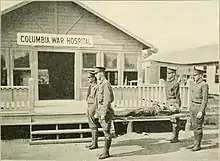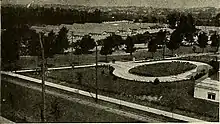U.S. Army General Hospital No. 1
U.S. Army General Hospital No. 1, also known as Columbia War Hospital, was a World War I era field hospital built by Columbia University on the Columbia Oval property in Norwood, The Bronx. The hospital was used as a medical training facility, a model for military field hospitals, and for long-term treatment of patients.[3]
| U.S. Army General Hospital No. 1 | |
|---|---|
| U.S. Army Medical Department | |
 General Hospital Number 1. | |

| |
| Geography | |
| Location | Columbia Oval (Gun Hill Road and Bainbridge Avenue), Norwood, The Bronx[1], New York, United States |
| Coordinates | 40.881025°N 73.876501°W |
| Organization | |
| Care system | U.S. Army Medical Department |
| Funding | Government hospital |
| Type | General |
| Affiliated university | Columbia University |
| Services | |
| Beds | Over 1,000[1] |
| History | |
| Former name(s) | Columbia War Hospital |
| Opened | July 1917 |
| Closed | October 15, 1919[2] |
| Links | |
| Lists | Hospitals in the United States |
| Other links | |
Columbia Oval
The property that the hospital was built on was an athletic field owned by Columbia University called "Columbia Oval". The property, located in what was then considered part of the Williamsbridge neighborhood, but is now part of the Norwood neighborhood. Columbia Oval was the finish line of the first marathon within the United States, which was won by John McDermott in 1896,[4] a year before he won the first Boston Marathon in 1897.
Columbia War Hospital
The Columbia War Hospital was conceived by the head of Columbia's Department of Urology, J. Bentley Squier in March, 1917[5][1] Construction began the following month, and the hospital was ready to admit patients by May 30, 1917.[1]
U.S. Army General Hospital No. 1
The hospital was renamed by the army to "United States Army General Hospital No. 1" in August, 1917.[6] The hospital was transferred over to Colonel E. R. Schreiner of the United States Army on October 3, 1917 in a ceremony conducted by Columbia university's president Nicholas Murray Butler.[3]
Additional facilities
The hospital had additional facilities in:[1]
- The Montefiore Home, (Norwood, Bronx), located across the street from the hospital, provided accommodations for military officers at a newly created facility called "Van Cortlandt Private Hospital".[1][7]
- The Messiah Home for Children, 1771 Andrews Avenue University Heights, Bronx, and the adjacent Camp Estate,[8] both provided by the Catholic War Council with a nominal rent of $1 per month.[1]
- Bloomingdale Hospital (in White Plains, New York)[1][9]
Later history
The hospital was closed on October 15, 1919.[2] After the end of the Great War, the 54 buildings that made up the Columbia Oval site were razed.[7] Former patients who required long-term care after the closing of the hospital were transferred to the care of Montefiore Medical Center.[7] In October 1922 the 19 acre site was auctioned by the university for a total of $351,950 as 225 separate lots.[10][11] ($5,445,127.39 in 2020 US dollars per www.usinflationcalculator.com.) One of the streets created on the former field is named "Kings College Place", after Columbia University's original name.[7]

_NYPL2003039.tiff.jpg.webp)

See also
References
- "Military Hospitals in the U.S. - Chapter 25 - Other General Hospitals". army.mil. United States Army, Office of Medical History. Retrieved August 31, 2020.
- "Archives & Special Collections, Columbia University Health Sciences Library Yaskin and Herrick "History"" (PDF). Retrieved October 4, 2020.
- "New York Tribune Newspaper Archives, Oct 4, 1917, p. 18". NewspaperArchive.com. New York Tribune. October 4, 1917. Retrieved September 19, 2020.
- Kennedy, Patrick L. (September 19, 2020). "There Was a Marathon in New York in 1896". The New York Times. Retrieved January 6, 2018.
- "Public Service and J. Bentley Squier - Didusch Museum". urologichistory.museum. Retrieved September 25, 2020.
- "RENAME COLOMBIA HOSPITAL; Will Be Known as United States Army General Hospital No. 1". The New York Times. August 26, 1917. Retrieved September 25, 2020.
- Dolan, Meaghan (July 18, 2002). "Looking Back: World War I Soldiers Called Norwood Home". Norwood News. 15 (14). Monsholu Preservation Corporation. Archived from the original on November 1, 2010. Retrieved September 25, 2020.
- "Messiah Home for Children, 1771 Andrews Avenue, Bronx, Bronx County, NY". Library of Congress, Washington, D.C. 20540 USA. Retrieved September 10, 2020.
- Stuhler, Linda S. (2011). The inmates of Willard, 1870 to 1900 : a genealogy resource (PDF). ISBN 978-1463738006. Retrieved September 19, 2020.
- "COLUMBIA OVAL SOLD FOR $351,950; Former Athletic Field, Divided into 225 Lots, Sold at Auction. $1,564 AVERAGE PER PLOT Corner of Gun Hill Road and Bainbridge Avenue Brought$8,000". The New York Times. October 27, 1922. Retrieved September 25, 2020.
- "TO SELL COLUMBIA OVAL.; Gun Hill Road Field Will Be Offered at Auction". The New York Times. October 8, 1922. Retrieved September 25, 2020.
External links
| Wikimedia Commons has media related to U.S. Army General Hospital No. 1. |